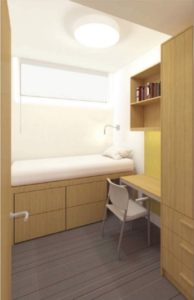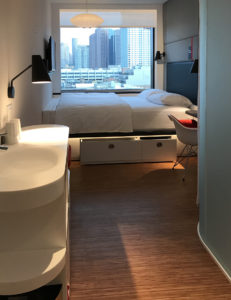

Features
Munger Hall Meets Hans Christian Anderson
Bill Browning
Share
Over the years I have noticed that while good ideas come and go, truly bad ideas take on a life of their own. Some ideas even move into the realm of what Amory Lovins calls ‘spherically stupid’—stupid from any direction you look.

A typical dorm room at Munger Hall, UCSB. Rendering courtesy UCSB / Santa Barbara Independent
Billionaire Charlie Munger is giving the University of California Santa Barbara $200 million to fund less than 20% of the cost for building a dorm to house over 4,500 students, with the requirement that it be built to his design. Likened to the formidable Borg cube, Munger Hall is an 11 story, 1.8 million square foot shoebox with fewer than 10% of the spaces having windows. In many places, building codes require operable windows in every bedroom, but through a quirk of historical land ownership transfer, UCSB is not subject to local building codes.
Students will be sentenced to windowless cells arranged in clusters of eight, sharing a kitchen and one toilet and shower. Each cell will have a bed, chair, desk/bookshelf and closet. On the wall above the bed, renderings show a ‘artificial window’ panel that mimics daylight. In an interview with CNN Business, Munger says these windows will feature the “exact spectrum as daylight”,1 and that students can dial that light up and down any time. This free and easy mentality indicates a total lack of understanding of the biological circadian cycle and the negative health impact of having a certain spectrum mix at the wrong time of day, or night. The prefabricated modular room units are said to be inspired by the windowless interior cabins found on cruise ships; it’s worth noting that the average cruise trip is 7 nights in duration,2 not 9 months. To top it off, with eight people to a bathroom, a (Borg-like) collective consciousness or, more likely, isolationism seems necessary to achieve peaceable living.
On the energy efficiency side, I would be hard pressed to think of a more perfect place in the United States to site a passive building. UCSB is located on the shore of the Pacific Ocean in Goleta, in Santa Barbara County. With one of the most benign climates in the entire country, (to geek out for a moment) the upper design temperature at the 0.4% condition is 82.9°F. There are 1,902 heating degree days and 470 cooling degree days, meaning this building typology could easily be designed for passive daylighting, heating and ventilation to yield a low carbon footprint and passive survivability. Yet, Munger Hall is entirely dependent on electrical lighting and mechanical ventilation; when the power goes off, this facility will be uninhabitable.
Windows with views to nature have a number of documented health and psychological benefits. From the research of Peter Kahn and his colleagues, we know that an artificial window broadcasting (in real time) a view of nature is more beneficial than no window, but does not match the health benefits of experiencing a real window.3 Staring at a view of nature, even for just 40 seconds, quiets down the prefrontal cortex and restores cognitive capacity4—critical for students continually confronted with academic and social stressors. A panel mimicking daylight, even if its design utilizes circadian effective lighting, does not give the eyes a chance to focus on a distant view, which allows the lens to flatten and the eye muscles to relax and, ultimately, mitigate eye strain and headaches. Additionally, as a substitute for a window, a light panel will never capture the fleeting variability of light that helps keep our attention, allow us to see and hear the birds chirping in the trees, or connect us to the weather and the time of day.
An enormously better model for dense housing, that also uses modular construction from the shipbuilding industry, are the citizenM hotels. Like Munger Hall, the underlying concept is small individual rooms and generous shared common spaces. The width of a citizenM guest room is narrow – determined by the length of the bed, which is set up against an enormous window – and includes a sink, desk, closet, storage under the bed, and partitioned shower and toilet. The space is beautifully designed and thoughtfully detailed. As we documented in Human Spaces 2.0, the lobby of a citizenM hotel is a great example of biophilic design that encourages people to gather and socialize. This hotel chain’s design is an example of what could have been done at Munger Hall.
I want to applaud Mr. Munger for his charitable intention, as UCSB desperately needs more housing, and for the stated intention to be a ‘green building.’ It is unfortunate that in his effort to be spatially efficient and energy efficient he has created a building that is unfit for humans. To reference another of Amory’s expressions, Mr. Munger has ‘optimized for one component and pessimized the entire system’. The Munger Hall project is an unfortunate lost opportunity that draws on poor precedents, as chronicled by Charles Bethea in the Nov 13th New Yorker article.5 Why didn’t UCSB’s administration stand up to stupid design—design that goes against everything we know about sustainability and healthy living environments? Blinded by the billionaire’s bucks, I suspect they all forgot the lesson from the classic children’s parable of ‘The Emperor’s New Clothes’.
REFERENCES (1) CNN Business' Matt Egan interview with Charlie Munger on Nov 2, 2021. https://www.cnn.com/videos (2) 97% of all cruise trips are 4–14 nights, and the remaining 3% of the total are for 15+ nights, only a handful of which are up to 100 or 120 nights in duration. CLIA 2018 Global Passenger Report. (3) Peter Kahn, Batya Friedman, Brian Gill..., & Anna Stolyar (2008). A plasma display window?—The shifting baseline problem in a technologically mediated natural world. Journal of Environmental Psychology, 28(2), 192-199. https://doi.org/10.1016/j.jenvp.2007.10.008 (4) Kate E. Lee, Kathryn J.H. Williams, Leisa D. Sargent, Nicholas S.G. Williams, & Katherine A. Johnson (2015). 40-second green roof views sustain attention: The role of micro-breaks in attention restoration. Journal of Environmental Psychology, 42, 182-189. https://doi.org/10.1016/j.jenvp.2015.04.003 (5) Charles Bethea (November 13, 2021). Nightmare of the Windowless Dorm Room. The New Yorker, issue November 22, 2021. https://www.newyorker.com/magazine/2021/11/22/nightmare-of-the-windowless-dorm-room
This article was a collaboration between Bill Browning and Catie Ryan in response to media coverage in November 2021 of UCSB’s plans for Munger Hall, and is intended only to highlight critical concerns about the design plans relative to Terrapin’s areas of expertise, particularly in sustainability and biophilic design. For more in-depth information on these topics, visit and download the many free reports on our publications page.
Topics
- Environmental Values
- Speaking
- LEED
- Terrapin Team
- Phoebe
- Community Development
- Greenbuild
- Technology
- Biophilic Design Interactive
- Catie Ryan
- Spanish
- Hebrew
- French
- Portuguese
- Publications
- Occupant Comfort
- Materials Science
- Conference
- Psychoacoustics
- Education
- Workshop
- Mass Timber
- Transit
- Carbon Strategy
- connection with natural materials
- interior design
- inspirational hero
- biophilia
- economics of biophilia
- Sustainability
- wood
- case studies
- Systems Integration
- Biophilic Design
- Commercial
- Net Zero
- Resorts & Hospitality
- Energy Utilization
- Water Management
- Corporations and Institutions
- Institutional
- Ecosystem Science
- Green Guidelines
- Profitability
- Climate Resiliency
- Health & Wellbeing
- Indoor Environmental Quality
- Building Performance
- Bioinspired Innovation
- Biodiversity
- Residential
- Master Planning
- Architects and Designers
- Developers and Building Owners
- Governments and NGOs
- Urban Design
- Product Development
- Original Research
- Manufacturing
- Industrial Ecology
- Resource Management
- Sustainability Plans
- Health Care
- Carbon Neutrality



